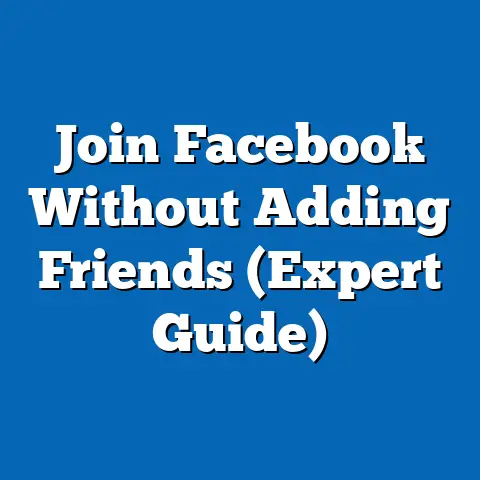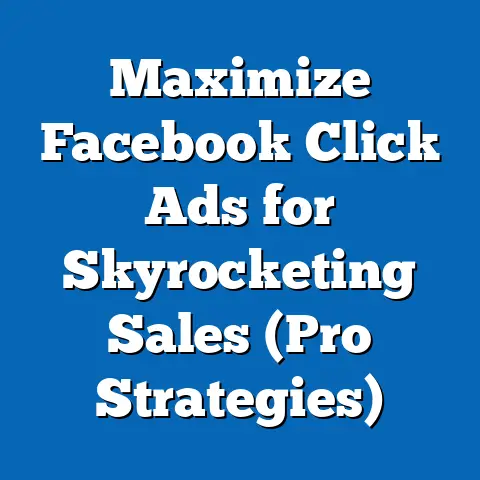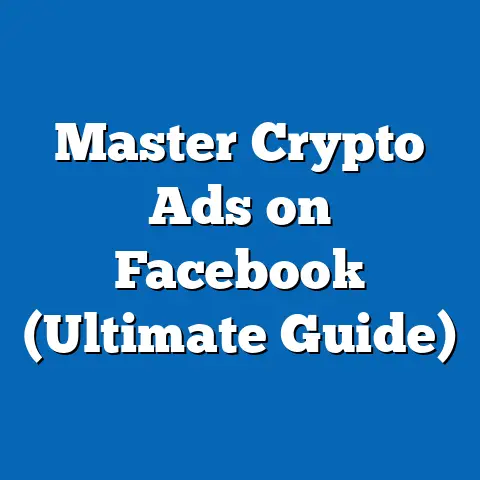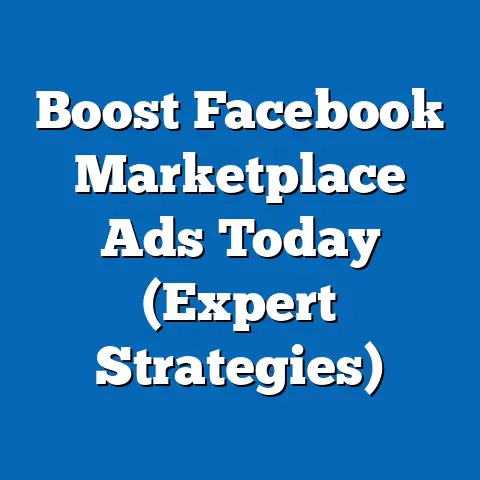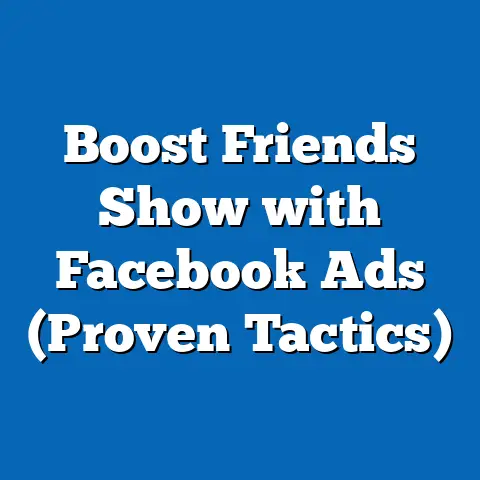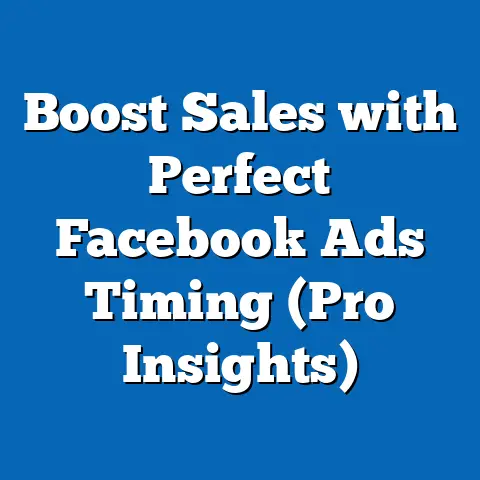Master Facebook Ads for Lead Generation (Effective Strategies)
In today’s digital marketing landscape, Facebook advertising stands as a powerful tool for businesses of all sizes. With billions of active users, Facebook provides an unparalleled opportunity to reach targeted audiences and generate high-quality leads. I’ve seen firsthand how a well-crafted Facebook ad campaign can transform a business, driving significant growth and boosting revenue. However, success on Facebook isn’t guaranteed. It requires a strategic approach, a deep understanding of the platform, and a commitment to continuous optimization.
I remember when I first started running Facebook ads for a local bakery. We initially threw a bunch of money at the platform with a generic “Come buy our pastries!” message, and the results were… underwhelming, to say the least. It wasn’t until we dug deep into understanding our ideal customer, crafting compelling ad copy, and utilizing the right ad formats that we started seeing a real return on investment. It was a tough learning curve, but it taught me the immense potential of Facebook ads when done right.
Expert Tip: Start with Clear Objectives
Before diving into the technical aspects of Facebook Ads Manager, it’s crucial to establish clear objectives for your campaign. This is often the most overlooked step, and I’ve seen many campaigns fail simply because they lacked a defined purpose. Think of it this way: you wouldn’t embark on a road trip without knowing your destination, right? Similarly, you shouldn’t launch a Facebook ad campaign without knowing what you want to achieve.
Having specific, measurable goals is critical for several reasons. First, it helps you target the right audience. If your objective is to increase newsletter sign-ups, you’ll target users interested in your industry or niche. Second, clear objectives guide your ad messaging. A campaign aimed at generating inquiries for a service will use different language than one promoting a free trial of a product. Finally, and perhaps most importantly, clear objectives allow you to measure your success accurately. Without a benchmark, you won’t know if your campaign is performing well or if it needs adjustments.
Here are some examples of different objectives you might set for your Facebook ad campaigns:
- Increase Newsletter Sign-Ups: This objective is ideal for building your email list and nurturing leads over time.
- Generate Inquiries for a Service: If you offer a service-based business, this objective can help you connect with potential clients who are actively seeking your expertise.
- Promote a Free Trial of a Product: This objective is perfect for showcasing the value of your product and encouraging users to try it out.
- Drive Traffic to a Landing Page: This objective can be used to direct users to a specific page on your website where they can learn more about your offerings.
- Increase Event Registrations: If you’re hosting a webinar, conference, or other event, this objective can help you attract attendees.
Takeaway: Define specific, measurable, achievable, relevant, and time-bound (SMART) objectives before launching any Facebook ad campaign. This will provide a clear roadmap for your efforts and ensure that you’re targeting the right audience, crafting the right message, and measuring your success accurately.
Understanding Your Audience
Once you’ve defined your objectives, the next crucial step is to understand your target audience. I can’t stress this enough: knowing your audience is the foundation of any successful marketing campaign. You can have the most visually stunning ad in the world, but if it’s shown to the wrong people, it’s going to fall flat.
Facebook offers a wealth of tools and insights to help you identify your target demographics, interests, and behaviors. One of the most valuable resources is Facebook Audience Insights. This tool allows you to explore the characteristics of people on Facebook based on factors like age, gender, location, interests, and behaviors. You can use this information to identify potential target audiences for your ads.
For example, let’s say you’re running a Facebook ad campaign for a new line of organic baby food. Using Audience Insights, you might discover that your target audience is primarily women aged 25-45, located in urban areas, who are interested in parenting, healthy eating, and organic products. You can then use this information to target your ads specifically to these users.
Another important aspect of understanding your audience is creating buyer personas. A buyer persona is a semi-fictional representation of your ideal customer, based on research and data about your existing customers and target audience. Creating buyer personas helps you to humanize your target audience and understand their motivations, goals, and pain points.
When creating buyer personas, consider the following factors:
- Demographics: Age, gender, location, income, education, occupation
- Psychographics: Interests, values, lifestyle, personality
- Goals and Challenges: What are they trying to achieve? What obstacles are they facing?
- Pain Points: What problems are they trying to solve? What frustrations are they experiencing?
- Information Sources: Where do they get their information? What websites, blogs, and social media platforms do they use?
By creating detailed buyer personas, you can tailor your ad messaging and creative strategies to resonate with your target audience on a deeper level. This will ultimately lead to higher engagement and more leads.
Segmentation is also key. Don’t assume that your entire target audience is homogenous. Segment your audience based on factors like demographics, interests, and behaviors to create more tailored ad experiences. For example, you might create separate ad campaigns for new parents versus experienced parents, or for users who are interested in different types of baby food.
Takeaway: Invest time in researching and understanding your target audience. Use Facebook Audience Insights to identify key demographics, interests, and behaviors. Create detailed buyer personas to humanize your audience and understand their motivations. Segment your audience to create more tailored ad experiences.
Crafting Compelling Ad Copy
Once you have a solid understanding of your target audience, it’s time to craft compelling ad copy that captures their attention and motivates them to take action. I’ve learned that effective ad copy is more than just writing a few catchy sentences. It’s about understanding your audience’s needs and desires and crafting a message that resonates with them on a personal level.
One of the most important elements of successful Facebook ad copy is the use of strong calls-to-action (CTAs). A CTA is a phrase that tells the user what you want them to do next, such as “Sign Up Now,” “Learn More,” or “Get a Free Quote.” Your CTA should be clear, concise, and action-oriented. It should also be prominently displayed in your ad.
For example, instead of saying “Visit our website,” you could say “Shop Now and Get 20% Off!” The latter CTA is more specific and enticing, and it clearly tells the user what they will get if they click on the ad.
Another key element of effective ad copy is addressing pain points. Your ad should identify a problem that your target audience is facing and then offer a solution. For example, if you’re selling a productivity app, you might address the pain point of feeling overwhelmed and disorganized. Your ad copy could say something like, “Feeling stressed and overwhelmed? Our productivity app can help you get organized and take control of your day.”
Persuasive language is also essential for crafting compelling ad copy. Use words that evoke emotion, create a sense of urgency, and highlight the benefits of your product or service. For example, instead of saying “Our product is effective,” you could say “Experience the amazing results of our product!”
Here are some examples of high-performing ad copy:
- Example 1 (Lead Magnet): “Want to learn the secrets to successful social media marketing? Download our free ebook and discover proven strategies to grow your audience and generate leads! [Link to ebook] #socialmediamarketing #leadgeneration #freeebook”
- Example 2 (Service-Based Business): “Tired of dealing with plumbing problems? Our experienced plumbers provide fast, reliable service at affordable prices. Call us today for a free quote! [Phone number] #plumbing #homerepair #emergencyplumbing”
- Example 3 (E-commerce Product): “Looking for the perfect gift? Our handcrafted jewelry is unique, beautiful, and made with love. Shop now and get free shipping on orders over $50! [Link to store] #jewelry #handmade #gifts”
The psychology behind what makes ad copy resonate is complex, but it boils down to understanding human needs and desires. People are motivated by things like solving problems, achieving goals, feeling good, and connecting with others. Your ad copy should tap into these motivations to create a compelling message that resonates with your target audience.
Takeaway: Craft compelling ad copy that uses strong CTAs, addresses pain points, and employs persuasive language. Study examples of high-performing ad copy and analyze the psychology behind what makes them effective. A/B test different versions of your ad copy to see what resonates best with your target audience.
Visual Elements and Ad Design
While compelling ad copy is crucial, don’t underestimate the power of visual elements in Facebook ads. I’ve found that high-quality images, videos, and infographics can significantly boost engagement and drive more leads. In fact, Facebook itself has stated that visuals are a key component of successful ads. Think about it: we’re all scrolling through our feeds at lightning speed. A captivating visual is what stops us in our tracks.
Best practices for ad design include using high-quality images that are relevant to your ad copy and target audience. Avoid using blurry or pixelated images, as they can make your ad look unprofessional. Videos are also a great way to capture attention and convey your message in a dynamic way. Keep your videos short and engaging, and make sure they are optimized for mobile viewing. Infographics can be used to present complex information in a visually appealing format.
Aligning visuals with brand identity and messaging is essential for creating a cohesive and recognizable brand experience. Use consistent colors, fonts, and imagery in your ads to reinforce your brand identity. Your visuals should also support your ad messaging and help to communicate your value proposition.
A/B testing different visual elements is a great way to see what resonates best with your target audience. Try testing different images, videos, and infographics to see which ones generate the most engagement and leads. You can also test different layouts and designs to optimize the visual appeal of your ads.
I recall a campaign I ran for a travel agency. We initially used stock photos of generic beaches, and the results were mediocre. However, when we switched to using authentic photos of real travelers enjoying the agency’s tours, the engagement skyrocketed. It was a clear demonstration of how important it is to use visuals that are relatable and authentic.
Takeaway: Invest in high-quality visuals that are relevant to your ad copy and target audience. Align your visuals with your brand identity and messaging. A/B test different visual elements to see what resonates best with your target audience.
Utilizing Facebook Ad Formats
Facebook offers a variety of ad formats, each with its own unique advantages and use cases. Understanding these different formats and how to leverage them effectively is crucial for maximizing your lead generation efforts. I’ve found that choosing the right ad format can make a significant difference in the performance of your campaign.
Here are some of the most popular ad formats for lead generation:
- Carousel Ads: Carousel ads allow you to showcase multiple images or videos in a single ad. This format is ideal for showcasing a range of products, highlighting different features of a product, or telling a story.
- Slideshow Ads: Slideshow ads are a cost-effective way to create engaging video-like experiences using still images. This format is great for showcasing a process, creating a tutorial, or highlighting key benefits.
- Lead Generation Ads: Lead generation ads allow users to submit their contact information directly within the Facebook ad, without having to leave the platform. This format is ideal for collecting leads for newsletters, free trials, or other offers.
- Single Image/Video Ads: These are the most basic ad formats, allowing you to showcase a single image or video. They’re great for simplicity and directness, especially when combined with strong visuals and compelling copy.
When to use each format depends on your specific campaign goals and audience preferences. For example, if you’re trying to showcase a range of products, carousel ads might be the best option. If you’re trying to collect leads for a newsletter, lead generation ads would be a great choice. If you have a compelling video, a single video ad might be the most effective.
I remember when I was running a campaign for a local restaurant. We initially used single image ads, but the results were underwhelming. However, when we switched to using carousel ads to showcase different dishes on the menu, the engagement and reservations skyrocketed. It was a clear demonstration of how important it is to choose the right ad format for your specific goals.
Takeaway: Explore the various ad formats available on Facebook and understand the unique advantages of each format. Choose the right ad format based on your specific campaign goals and audience preferences. A/B test different ad formats to see which ones generate the most engagement and leads.
Retargeting and Follow-Up Strategies
Retargeting is a powerful technique that allows you to re-engage users who have interacted with your previous ads or visited your landing page. I consider retargeting to be an essential component of any successful lead generation campaign. It’s a way to nurture leads, remind them of your offer, and ultimately convert them into customers.
Setting up retargeting campaigns involves creating custom audiences based on specific criteria, such as users who have visited your website, users who have engaged with your Facebook page, or users who have submitted a lead form. You can then target these custom audiences with specific ads that are tailored to their previous interactions.
For example, you could create a custom audience of users who have visited your website but haven’t yet submitted a lead form. You could then target these users with an ad that offers a special discount or incentive to encourage them to submit their information.
Effective follow-up strategies are crucial for nurturing leads through the sales funnel. This involves creating a series of ads that are designed to educate leads about your product or service, address their concerns, and ultimately convince them to make a purchase.
For example, you could create a series of ads that showcase customer testimonials, highlight key benefits, or offer a free trial. You could also use dynamic ads to personalize your ads based on the user’s previous interactions with your website or Facebook page.
I once ran a retargeting campaign for an online course. We targeted users who had visited the course landing page but hadn’t yet enrolled. We created a series of ads that showcased student success stories, highlighted the course’s key benefits, and offered a limited-time discount. The result was a significant increase in course enrollments.
Takeaway: Set up retargeting campaigns to re-engage users who have interacted with your previous ads or visited your landing page. Create custom audiences based on specific criteria. Develop effective follow-up strategies to nurture leads through the sales funnel. Use dynamic ads to personalize your ads based on the user’s previous interactions.
Conclusion
Mastering Facebook ads for lead generation requires a strategic approach, a deep understanding of the platform, and a commitment to continuous optimization. By defining clear objectives, understanding your audience, crafting compelling ad copy, utilizing effective visuals, choosing the right ad formats, and implementing retargeting and follow-up strategies, you can effectively utilize Facebook ads to generate high-quality leads and grow your customer base.
I’ve seen firsthand the transformative power of Facebook ads when done right. It’s not about throwing money at the platform and hoping for the best. It’s about taking a data-driven approach, understanding your audience, and crafting a message that resonates with them on a personal level. By following the strategies outlined in this guide, you can unlock the full potential of Facebook ads and drive real results for your business. Now go out there and start generating those leads!

